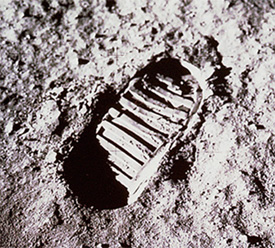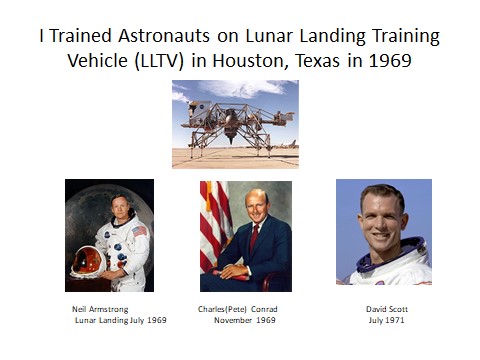First-Hand:Astronaut Training on Lunar Landing Training Vehicles (LLTVs)

Submitted by Henry A. Siemienowski
I am Henry A. Siemienowski, a long time IEEE member. First I was employed from 1960 to 1966 in Long Island, NY as Engineer at Sperry Gyroscope Co. and worked on Long Range Navigational and Inertial Navigational Systems and then as an Electronics Engineer at Bell Aerosystems Company (BAC), a Textron Company, located in Niagara Falls, NY, from 1967 to 1970. Then I joined Gibbs & Hill Inc., an Engineering and Design Co., and its successors in NYC and Princeton, NJ until my retirement as, Consulting Engineer, in 2014.
I was born in Poland and came here at twelve with my parents, sister and grandmother in mid of 1951. I completed the Father Baker High School in Lackawanna, NY and then got two degrees BSEE and BSME at University of Buffalo In Feb.1960 and June, 1960. The Bell Aerosystems Company built two LLRVs (lunar landing research vehicles) and three LLTVs (lunar landing training vehicles). Early in 1969 BAC asked a number of their engineers to go to Ellington Air Force Base and get these LLTV vehicles prepared for testing and getting them ready for the astronaut training flights. I was asked by Bill Grubb, my boss at BAC to go to Houston, Texas and train the astronauts on the theory and operation of the LLTVs. I agreed to go for only one year, since my mother was not feeling well and she had my younger sister and brother, born in Buffalo area, still going to school. My father passed away just a few years earlier. My boss agreed. Soon, after getting some LLTV training in the factory and after getting some documents prepared, I went to Houston, TX where at Ellington Air Force Base, I completed the training material and trained the astronauts on LLTVs, starting with Apollo 11 flight. I rented my apartment near the NASA Johnson Space Center, close to Houston, Texas. I trained the following astronauts, Neil Armstrong, Charles “Pete” Conrad and David Scott, who landed on the moon. Edwin Aldrin, Alan Bean and James Irwin accompanied Neil Armstrong, Charles Conrad and David Scott listed above. Although Neil Armstrong had to eject from the LLRV, none of these astronauts, ever had to eject from the LLTV. Every Lunar Module pilot through the final Apollo 17 mission trained on the LLTV and flew to a landing on the Moon successfully.
Neal Armstrong after return from the moon stated:
Eagle (the Lunar Module) flew very much like the Lunar Landing Training Vehicle which I had flown more than 30 times at Ellington Air Base near the Space Center. I had made from 50 to 60 landings in the trainer, and the final trajectory I flew to the landing was very much like like those flown in practice. That, of course, gave me a good deal of confidence – a comfortable familiarity.
Jim Lovell went to the moon on Apollo 13 but never landed there. His Apollo 13 was the third Apollo mission intended to land on the Moon. That mission, launched on April 11, 1970, was aborted as a fault in electrical equipment inside one of the Service Module’s oxygen tanks produced an explosion which caused the loss of both tanks’ oxygen, depriving the Service Module of electrical power.
The electronic control system for the Lunar Landing Training was also developed for NASA by Bell Aerosystems, Inc. which had engineering facilities located in Niagara Falls, New York. The LLTV was a second generation vehicle, after the Lunar Landing Research Vehicle, LLRV used by NASA Apollo Program astronauts to develop piloting skills. The LLTV provided Apollo program commanders the opportunity to experience the flight characteristics associated with the 1/6 gravity conditions on the Moon. The first LLTV vehicle was assembled at Ellington Airforce Base in Houston, Texas in 1967. A total of 3 LLTV vehicles were eventually delivered to Ellington AFB. The last remaining of the three LLTV vehicles is on display at the Johnson Spacecraft Center. Two LLTV vehicles later crashed during training, all pilots survived, they ejected.
A short detailed descripton of control system, is now available on internet and provided by Alan R. Kronenwetter, an avionics electrical engineer, employed by Bell Aerosystems, Inc. in Niagara Falls, NY from Jan. 1967 through Jan.1969. First he was responsible for development of the LLTV electronic control system in Niagara Falls and then for its preflight testing and control system modifications at Ellington AFB.
The electronic control system for the LLTV was designed with redundant channels that used 2 of 2 logic. The outputs of each primary channel was compared on a continuous basis. If a fault was detected in the primary control system, then control was automatically switched to an identical backup channel and the pilot immediately took measures to bring the vehicle to the ground. All the controls were analog circuits utilizing Burr-Brown transistor amplifier modules and other analog components. Unlike modern digital control circuits used on NASA systems on the Shuttle program the technology available in 1967 was limited to discrete transistors.
Built of aluminum alloy trusses and shaped like a giant four-legged bedstead, the LLTV was built to simulate the dynamics of the actual Apollo Lunar Landing Module (LM). The LLTV had a General Electric CF-700-2V turbofan engine (with 4,200 pounds of thrust) that was mounted vertically in a gimbal. The turbofan engine provided the necessary lift to place the vehicle at the test altitude. Once at altitude the engine was then throttled back to support five-sixths of the vehicle's weight, simulating the reduced gravity of the moon. Two hydrogen peroxide lift rockets with thrust that varied from 100 to 500 pounds provided the balance of the vertical lift control. Sixteen smaller hydrogen peroxide rockets, mounted in pairs, provided control in pitch, yaw and roll. The LLTV electronic control system provided independent analog circuit channels for each of the pitch, yaw and roll hydrogen peroxide attitude rockets.
I prepared the training material for the first three astronauts described above (also, see below) and answered any questions raised by them during the training. Then in the end of 1970, per my agreement with the company, I returned back to Buffalo, NY and returned my training documents to my boss.
Some personnel involved with me at Bell Aerosystems Co. included Mr. J. T. Gorham, Mr. J.R. Cowan, Mr. Wantuck, Mr. V.Miliauskas, Mr. A. Chempinski and others.
Attached is the Bell Aerosystems Co. letter acknowledging my acceptance of their job offer in 1967.
